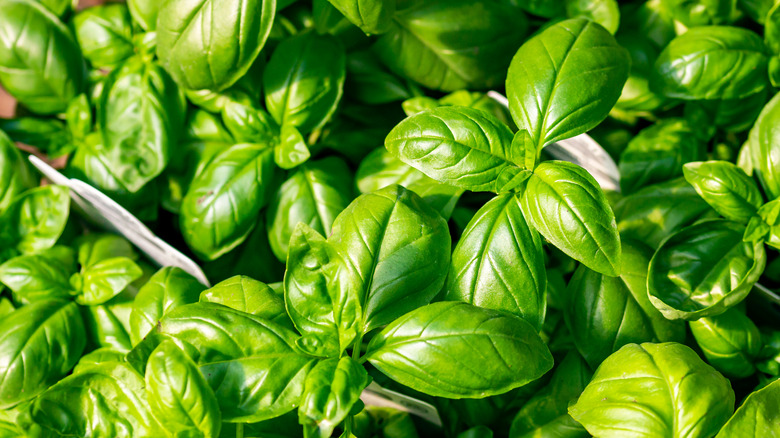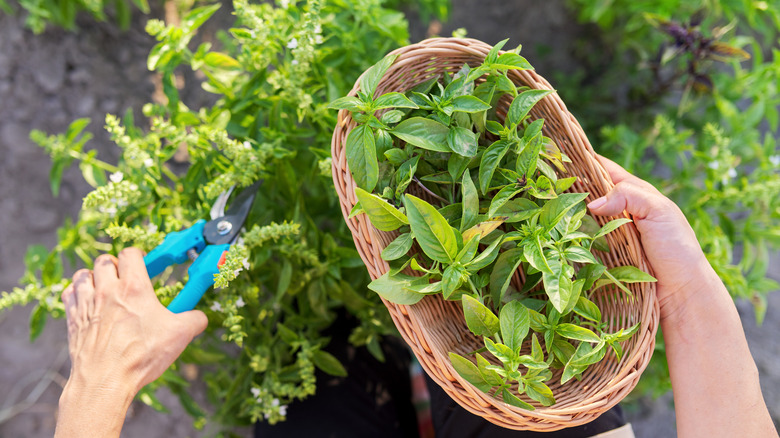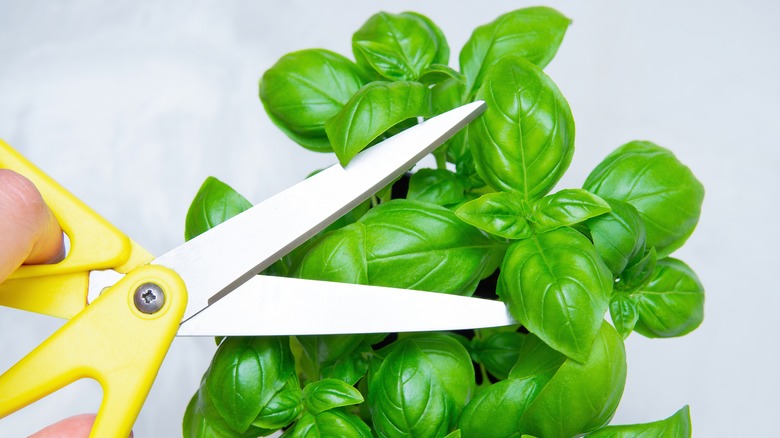Why Pruning Your Basil Plant Is Key To Maximum Yield
A common garnish for pizza, pasta, and other beloved dishes, basil is one of the most popular herbs grown and consumed in the U.S., likely due to its versatility, generally mild flavor, and ability to grow in a variety of conditions. On top of this, basil is part of the easiest herbs to manage, making the plant a great first choice for gardeners with less experience. If you prune your basil plant regularly, you will achieve maximum yield because it allows the plant to grow exponentially throughout its life and offer the best flavor when harvested. And because it's an annual crop, it proliferates in ideal conditions.
Basil needs ample sunshine and well-irrigated soil to survive at its healthiest, and it can reach adulthood after just one or two months. Combined with proper pruning, these factors allow basil crops to reach their fullest potential. Novice gardeners may avoid putting pruning shears on their basil plants too soon out of fear of killing them or permanently stunting their growth. But trimming basil at least every few weeks, starting from its time as a seedling, ensures the plant will grow as full and bushy as possible once fully matured. Here's more on pruning basil plants and why doing so is essential.
How to prune basil
When growing basil from seed, gardeners can begin pruning the plants as soon as they develop leaves. Once matured, leaves should be trimmed every 2 to 3 weeks to keep the plant's exponential growth persistent. Use pruning shears or sharp scissors to cut back your leaves. You can also remove the excess growth using your fingers, though a clean cut is necessary to ensure new basil leaves grow back healthy and strong. Basil can grow up to 2 feet tall under ideal conditions, but estimates fluctuate depending on the type of basil planted.
It's important to prune basil plants during the appropriate season to warrant maximum growth, as cutting back the stems and leaves at the wrong time can negatively impact the plant's overall development. Basil's active growing season begins toward the end of spring, but the crop performs best in the summertime when soil is at its warmest and sunlight is most prominent.
For the best results, begin growing basil indoors no sooner than two weeks after the last frost of spring. Afterward, transport your plants outside when the basil is strong enough to survive the shifting conditions that the outdoors may inflict. If you intend to grow basil plants for consumption, pruning becomes even more vital, as leaving the plant to flower will cause the leaves to undergo a chemical change and develop a bitter taste.
Why pruning is important
Pruning encourages increased development during a plant's active growing season. This could mean stripping a plant of certain leaves, branches, or flowers to see it grow more efficiently in the future. Usually, the plant parts being trimmed away are dying or diseased, so removing them allows the remaining healthy parts to grow unrestricted. But pruning may also involve stripping away perfectly healthy parts of the plant, either for consumption or to be used for decoration or resale.
Pruning is also essential to getting the most out of plants, like basil, before they perish at the end of their active growing season. Basil dies off during the winter and must be replanted until spring ends once the weather warms up. Properly pruning basil is the key to ensuring the crop yields more in its short lifespan. Pruning also delays the growth of flowers, which begin to appear on the plant near the end of its growing season.


